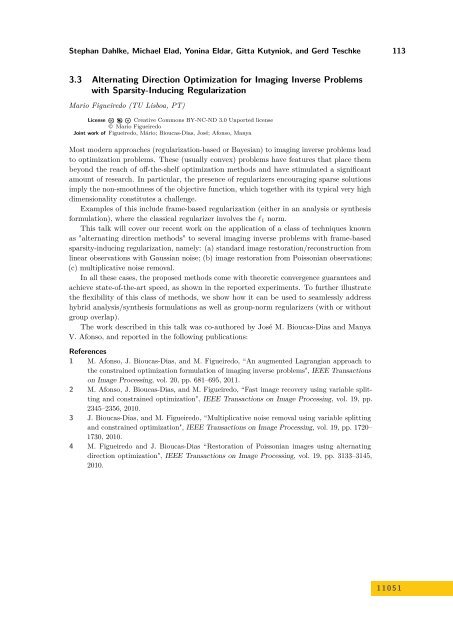Volume 1, Issue 1, January 2011 - DROPS - Schloss Dagstuhl
Volume 1, Issue 1, January 2011 - DROPS - Schloss Dagstuhl
Volume 1, Issue 1, January 2011 - DROPS - Schloss Dagstuhl
Create successful ePaper yourself
Turn your PDF publications into a flip-book with our unique Google optimized e-Paper software.
Stephan Dahlke, Michael Elad, Yonina Eldar, Gitta Kutyniok, and Gerd Teschke 113<br />
3.3 Alternating Direction Optimization for Imaging Inverse Problems<br />
with Sparsity-Inducing Regularization<br />
Mario Figueiredo (TU Lisboa, PT)<br />
License Creative Commons BY-NC-ND 3.0 Unported license<br />
© Mario Figueiredo<br />
Joint work of Figueiredo, Mário; Bioucas-Dias, José; Afonso, Manya<br />
Most modern approaches (regularization-based or Bayesian) to imaging inverse problems lead<br />
to optimization problems. These (usually convex) problems have features that place them<br />
beyond the reach of off-the-shelf optimization methods and have stimulated a significant<br />
amount of research. In particular, the presence of regularizers encouraging sparse solutions<br />
imply the non-smoothness of the objective function, which together with its typical very high<br />
dimensionality constitutes a challenge.<br />
Examples of this include frame-based regularization (either in an analysis or synthesis<br />
formulation), where the classical regularizer involves the ℓ1 norm.<br />
This talk will cover our recent work on the application of a class of techniques known<br />
as "alternating direction methods" to several imaging inverse problems with frame-based<br />
sparsity-inducing regularization, namely: (a) standard image restoration/reconstruction from<br />
linear observations with Gaussian noise; (b) image restoration from Poissonian observations;<br />
(c) multiplicative noise removal.<br />
In all these cases, the proposed methods come with theoretic convergence guarantees and<br />
achieve state-of-the-art speed, as shown in the reported experiments. To further illustrate<br />
the flexibility of this class of methods, we show how it can be used to seamlessly address<br />
hybrid analysis/synthesis formulations as well as group-norm regularizers (with or without<br />
group overlap).<br />
The work described in this talk was co-authored by José M. Bioucas-Dias and Manya<br />
V. Afonso, and reported in the following publications:<br />
References<br />
1 M. Afonso, J. Bioucas-Dias, and M. Figueiredo, “An augmented Lagrangian approach to<br />
the constrained optimization formulation of imaging inverse problems", IEEE Transactions<br />
on Image Processing, vol. 20, pp. 681–695, <strong>2011</strong>.<br />
2 M. Afonso, J. Bioucas-Dias, and M. Figueiredo, “Fast image recovery using variable splitting<br />
and constrained optimization", IEEE Transactions on Image Processing, vol. 19, pp.<br />
2345–2356, 2010.<br />
3 J. Bioucas-Dias, and M. Figueiredo, “Multiplicative noise removal using variable splitting<br />
and constrained optimization", IEEE Transactions on Image Processing, vol. 19, pp. 1720–<br />
1730, 2010.<br />
4 M. Figueiredo and J. Bioucas-Dias “Restoration of Poissonian images using alternating<br />
direction optimization", IEEE Transactions on Image Processing, vol. 19, pp. 3133–3145,<br />
2010.<br />
1 1 0 5 1













